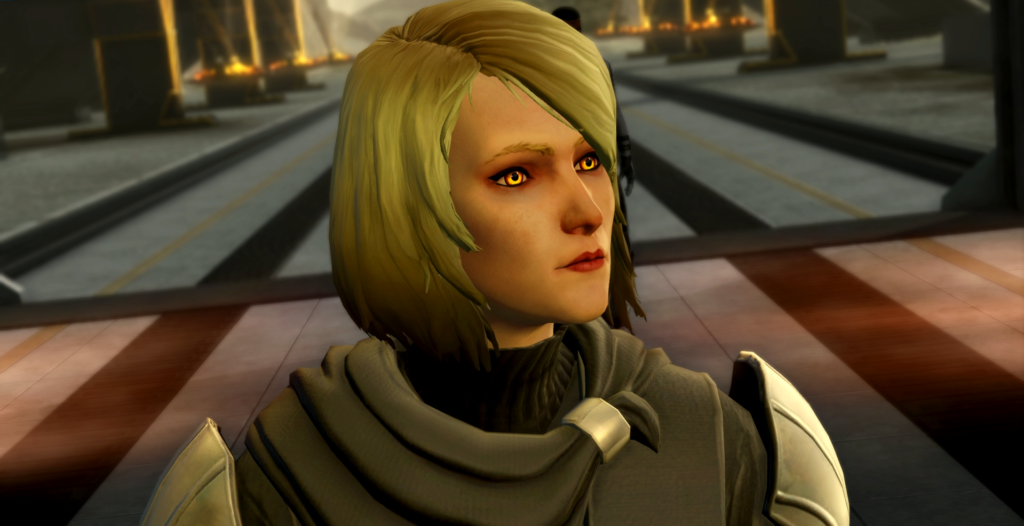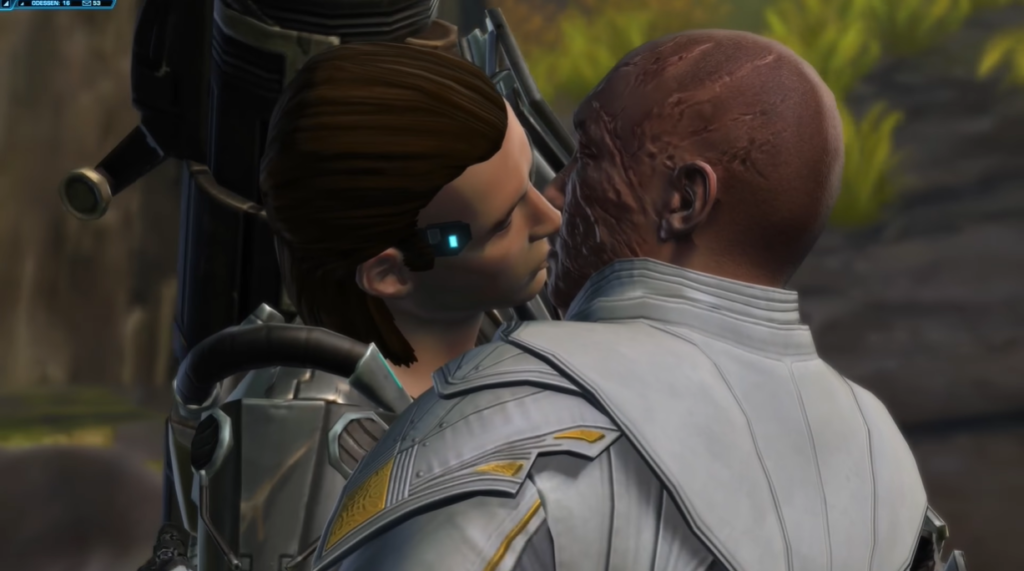LGBTQ+ representation Star Wars: The Old Republic is complicated but rewarding
It’s no secret that BioWare games have become known for their romances and their LGBTQ+ representation, and Star Wars: The Old Republic (also known as SWTOR) is no exception to that. Often times LGBTQ+ representation in video games is a story of scraps and/or fans fighting to get more than scraps. But no, the Star Wars MMO that so many people were looking forward to started out as worse than that. There was nothing, no same-sex romances at all. They had one bisexual character, Kaliyo Djannis, and she was only romanceable by a male Imperial Agent player character.
Star Wars: The Old Republic was initially released in December 2011 with only “straight” romances for players and zero LGBTQ+ options. For almost two years, this standard was kept within the game until the release of the expansion Rise of the Hutt Cartel in April 2013. Rise of the Hutt Cartel introduced the game’s first LGBTQ+ characters with Lemda Avesta, a bi woman, and Lord Cytharat, a gay man. The initial issue with Rise of the Hutt Cartel was that while the base SWTOR game was free to play, which meant all of the straight romances were free for players, expansions such as this required a paid subscription. This meant that LGBTQ+ players had to pay to see their representation while straight players did not.
Roughly a year later in December 2014, the next expansion, Shadow of Revan, introduced two more bisexual romances, Lana Beniko and Theron Shan – the game’s first bi man. However, just like Rise of the Hutt Cartel, this expansion required a subscription to play. This maintained the game’s standard of making players pay to see LGBTQ+ representation and experience same-sex romances. This continued in 2015 with the Knights of the Fallen Empire (KOTFE) and 2016 with the Knights of the Eternal Throne (KOTET) expansions that brought Lana and Theron back, and introduced another bi romance with Koth Vortena but continued to require a subscription.
I started playing SWTOR in 2017. Theron Shan was the first character I learned about and as a bi person myself, I latched onto him and then Lana, and then I fell in love with Lemda, Cytharat, and Koth. But I had no money. I couldn’t afford to subscribe and thus I had no hopes of ever being able to meet these characters anytime soon. I could meet Kaliyo in the Agent class story for free, but because her romance was only available to a male Imperial Agent, I struggled to feel represented by her and thus represented by this game.

Then later in 2017, BioWare announced they were giving players a code to redeem so that they could get Rise of the Hutt Cartel and Shadow of Revan for free. I honestly don’t think I’ve ever redeemed a code so fast before in my life. They repeated this again in 2018 but it held the same problem it did a year earlier: it was temporary. The code was only available to be redeemed for a limited time, and players who missed it or joined after had no access to it. Unbeknown to us, however, it seemed this was only the beginning.
With expansions such as Jedi Under Siege (December 2018) and Onslaught (October 2019), so much changed for SWTOR in regards to its LGBTQ+ representation. Jedi Under Siege started the game’s new standard of bringing back characters previously only available for “straight” romances and making them bisexual, such as Jaesa Wilsaam and Nadia Grell. This change not only shows that SWTOR listen to fans, as players have been asking for more LGBTQ+ representation in SWTOR for years now, but that they also value their queer fans and value their representation. Onslaught continued this but it did one more thing: it made Rise of the Hutt Cartel and Shadow of Revan free for all players.
SWTOR has now had five “straight” romances return as bisexual. They have four more characters with bi flirt options that players are hoping are made into full-fledged bisexual romances.
Now, this isn’t to say SWTOR doesn’t still have problems. The majority of the LGBTQ+ characters still require paid subscriptions to meet or romance. Characters that have returned as bi are only available for same-sex romances in the expansions they’ve returned in and not the free class stories, where one could argue they’re still considered “straight” romances. Lemda, Cytharat, Lana, and Theron remain the only characters available for same-sex romances without needing to pay.
Even then, there are issues. It is very possible for a player to choose to leave Cytharat, the game’s only gay man, to die. Neither Lemda nor Cytharat (if left alive) has returned since the end of Rise of the Hutt Cartel. Cytharat remains the game’s only gay man and there are no romanceable lesbians. Kaliyo is also still only romanceable by male Imperial Agents despite being bi.

So why does this matter? What does this mean for SWTOR’s LGBTQ+ fans?
I am no stranger to fighting for better LGBTQ+ representation in video games. I know how hard that fight can be. I know how draining it can be. I know how it can just suck you dry of all hope. It would have been so easy for SWTOR’s developers and creative team to keep it as it was. After all, how often is it that we see changes actively made for the current game? Often it feels as if we’re being told to accept the scraps, if any are even present, in the current game but hope for better in the next all the while that very hope feels as if it’s just out of reach. We see this in franchises like Mass Effect by the exact same studio. Queer fans of Mass Effect are often left feeling as if they’re being told to accept the scraps of representation given to them, especially in regards to the original trilogy, and the studio only actively added representation back into a game – such as the character Jaal Ama Darav in Mass Effect Andromeda – after queer fans campaigned for months for them to do so.
Despite the fact that SWTOR is still getting new expansions and story updates, they could have very easily told players to just hope for better in the next Star Wars game. Instead, they stepped up and made changes that I don’t think any in the player base, or fandom, ever really expected. I don’t think anyone ever expected Rise of the Hutt Cartel or Shadow of Revan to be made permanently free to play. We hoped characters from the class stories would be made bi or queer, but in reality none of us thought they’d do it. I certainly didn’t think they’d ever do it. I wanted to hope, but LGBTQ+ players are so used to being let down or hurt by the video game industry. We’re used to games erasing our representation before we even get to see it, such as Mass Effect, or watching our representation get killed off like in The Last Of Us: Left Behind.
It’s almost poetic. Hope is such a theme in the Star Wars franchise and SWTOR gave us just that. No matter how small some may see these steps, they matter so much to so many players, or fans, because it sends the clear message that we matter to this game and the people behind it. We matter enough for them to start making improvements. With these improvements, they’ve made it clear that to them, LGBTQ+ players have a place in their game and have given us the gift of hope. Since these expansions, especially Onslaught, LGBTQ+ players have found it so much easier to hope for even better from SWTOR in the future.
Players have become more hopeful for more “straight” characters to return as bisexual. They have more hope for new characters to be introduced and likely be bisexual. With Rise of the Hutt Cartel and Shadow of Revan being free now, they can even better hope for expansions like KOTFE and KOTET to possibly be made free to play one day.
In an industry where it can often be so hard to believe better representation is coming, to feel as if we matter to the games we love, SWTOR has given us exactly what a Star Wars game should: a new hope.






